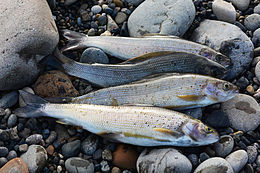
Salmonidae is a family of ray-finned fish that constitutes the only currently extant family in the order Salmoniformes, consisting of 11 extant genera and over 200 species collectively known as "salmonids" or "salmonoids". The family includes salmon, trout, char, graylings, freshwater whitefishes, taimens and lenoks, all coldwater mid-level predatory fish that inhabit the subarctic and cool temperate waters of the Northern Hemisphere. The Atlantic salmon, whose Latin name became that of its genus Salmo, is also the eponym of the family and order names.
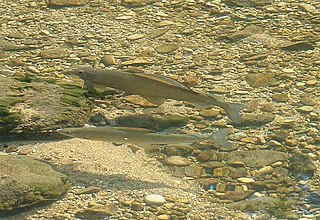
Thymallus thymallus, the grayling or European grayling, is a species of freshwater fish in the salmon family Salmonidae. It is the only species of the genus Thymallus native to Europe, where it is widespread from the United Kingdom and France to the Ural Mountains in Russia, and Balkans on the south-east, but does not occur in the southern parts of the continent. It was introduced to Morocco in 1948, but it does not appear to have become established there.
Grayling or Greyling may refer to:
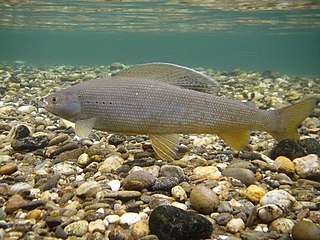
The Arctic grayling is a species of freshwater fish in the salmon family Salmonidae. T. arcticus is widespread throughout the Arctic and Pacific drainages in Canada, Alaska, and Siberia, as well as the upper Missouri River drainage in Montana. In the U.S. state of Arizona, an introduced population is found in the Lee Valley and other lakes in the White Mountains. They were also stocked at Toppings Lake by the Teton Range and in lakes in the high Uinta Mountains in Utah, as well as alpine lakes of the Boulder Mountains (Idaho) in central Idaho.

The Amur grayling is a species of freshwater ray-finned fish from the genus Thymallus (graylings) of the family Salmonidae, endemic to the Amur basin in Russian Far East and Northeast China and also the Onon and Kherlen basins in Mongolia. It is sometimes difficult to differentiate the species with the Lower Amur grayling. It is seen as a game fish and food fish in Russian Far East and the Chinese Heilongjiang province.
The East Siberian grayling(Thymallus pallasii) is a grayling in the salmon family Salmonidae. Males can reach a size of 44 cm (17 in).
Thymallus yaluensis, also known as Yalu grayling, is a putative species of freshwater ray-finned fish in the genus Thymallus (graylings) of the family Salmonidae. It is endemic to the upper Yalu River on the China-North Korea border.
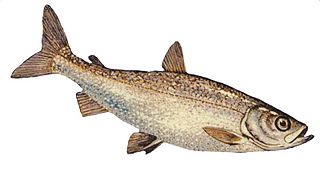
The freshwater whitefish are fishes of the subfamily Coregoninae, which contains whitefishes and ciscoes, and is one of three subfamilies in the salmon family Salmonidae. Apart from the subfamily Coregoninae, the family Salmonidae includes the salmon, trout, and char species of the subfamily Salmoninae, and grayling species of the subfamily Thymallinae. Freshwater whitefish are distributed mainly in relatively cool waters throughout the northern parts of the Northern Hemisphere.
Batrachocottus is a genus of freshwater ray-finned fishes belonging to the family Cottidae, the typical sculpins. These fishes are endemic to the Lake Baikal watershed in Russia.

The Montana Arctic grayling is a North American freshwater fish in the salmon family Salmonidae. The Montana Arctic grayling, native to the upper Missouri River basin in Montana and Wyoming, is a disjunct population or subspecies of the more widespread Arctic grayling. It occurs in fluvial and adfluvial, lacustrine forms. The Montana grayling is a species of special concern in Montana and had candidate status for listing under the national Endangered Species Act. It underwent a comprehensive status review by the U.S. Fish and Wildlife Service, which in 2014 decided not to list it as threatened or endangered. Current surviving native populations in the Big Hole River and Red Rock River drainages represent approximately four percent of the subspecies' historical range.

Thymallus baicalensis, also known as the Baikal black grayling, is a Siberian freshwater fish species in the salmon family Salmonidae.
Thymallus brevipinnis is a species of freshwater ray-finned fish belonging to the subfamily Thymallinae, the graylings, part of the family Salmonidae. This species is endemic to Lake Baikal in Siberia where it is benthopelagic. Some workers regard this taxon as a junior synonym of Thymallus baicalensis.
Thymallus ligericus, the Loire grayling, is a European freshwater fish species in the salmon family Salmonidae. The species is endemic to the upper Loire drainage in France, where it lives in medium to large foothill, canyon and plateau rivers of the mountainous regions.

The Kamchatka grayling is a grayling in the salmon family Salmonidae. The fish grows up to 50 cm (20 in). It is found in freshwater habitats of the Russian Far East, including the Kamchatka Peninsula, eastern part of Magadan Oblast and northwards to the southern Chukchi Peninsula.
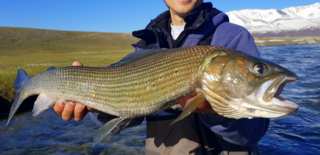
The Mongolian grayling is a freshwater species of fish of the genus Thymallus endemic to the landlocked rivers in Mongolia, Inner Mongolia Province of China and nearby parts of Russian far east. It is considered to be the largest grayling species in the world, and hence viewed as an auspicious sign by local tribes.
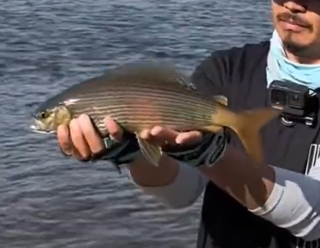
Thymallus svetovidovi, also known as the Upper Yenisei grayling, is a species of freshwater fish in the salmon family. It is found in the upper reaches of the Yenisei River and in western Mongolia.

Thymallus tugarinae, also known as the Lower Amur grayling, is a species of freshwater fish in the salmon family. It is found in the lower reaches of the Amur river on the border of the Russian far east and Heilongjiang Province of China. It was first described in 2007 and is sometimes mistaken for the Amur grayling.
Thymallus flavomaculatus, also known as yellow-spotted grayling, is a species of brackish-water fish in the salmon family. It is found in Khabarovsk and Primorsky Krai of the Russian Far East, as well as the Sea of Japan and the Sea of Okhotsk. They usually live near or on the bottom of the water body.
Thymallus nigrescens, also known as the Hovsgol grayling, is a species of freshwater fish in the salmon family. It is endemic to the Mongolian Lake Khovsgol where they usually live near or on the bottom of the lake.

